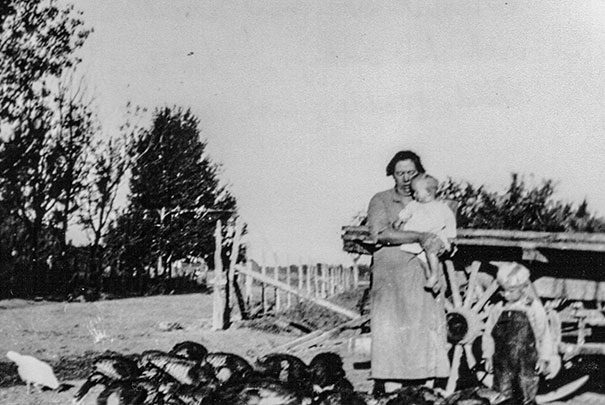My great-great-grandmother was Harriet Kidd Banner. She and her husband, Sam, homesteaded 80 acres in Idaho. It was on the Minidoka Southside Irrigation Project in 1908. Their homestead was located in Unity and was 5 miles southeast of Burley, Idaho. It was part of the vast and, arguably, last settled farm frontier in the country. This irrigation project and several just like it transformed a high desert into vibrant and productive farm ground. Today, the region is colloquially referred to as the “Magic Valley” because the irrigation changed the valley “as if by magic.”
Harriet was 25 years old at the time and had three children. She was a woman, a mother, a housewife, and she was a farmer – in every respect that her husband, Sam, was a farmer. In their lives the division of labor was apparent, but no lines were made of what was “women’s work” and what was a “man’s work.”
Like most settlers, they had two major concerns. The first was clearing the land for farming, and the second was providing an income. Sam secured a job with the Bureau of Reclamation and spent the majority of his time over the next three years digging the canal that would eventually bring water to their farm. Harriet was delegated the responsibility of clearing the land. They referred to the brutal task as “grubbing” the sagebrush.
In order to “grub,” a clearing contraption was constructed. Two 12-inch planks 4 feet long were attached to a railroad rail and the ends of the planks were dragged behind for the driver to stand. A team of horses was attached to each end of the rail. As the horses pulled the rail, the man (or woman, in this case) could move forward or backward, regulating the amount of weight needed to loosen the brush. It took a skilled teamster to handle both horse teams and balance on a moving platform.
Harriet was a skilled teamster and faithfully grubbed and stacked 80 acres of sagebrush. This was accomplished while caring for her three children – a 5-year-old, an 18-month-old and a 3-month-old. While she worked, her oldest son cared for his siblings. She returned to their tarpaper cabin every three hours to nurse her baby and see after the children. The daily 4-mile round-trip to the river to water livestock and fill the water barrels was also delegated to Harriet. To my modern sensibilities, her tasks seem unfathomable, but to Harriet they were simply work to accomplish.
Even after the farm was cleared and crops were planted, Harriet continued her farming enterprises. Throughout her life she raised poultry, maintained a dairy herd and made cheese and other dairy products to sell. Animal husbandry was as much part of her calling as housework.
While this fascinating piece of my family history is cherished by my woman’s spirit, Harriet’s story isn’t unique. I imagine most of our family histories are full of women in agriculture, women who sacrificed and scrapped and played an impressive role on their farms. Sadly, the history books and statistics are sorely lacking in their contribution. In the 1910 census, Sam Banner’s occupation is “farmer” while Harriet’s is “housewife.” In my estimation, both occupations should be applied to that strong and capable woman.
Since that census times have changed, and they are continuing to change. In the 2012 agriculture census, 30 percent of farms were primarily run by women, resulting in $12.9 billion in economic impact. But, like Harriet, those statistics don’t account for all of the wives and daughters who are not the “primary” operators but have as much responsibility when it comes to the farm as the men.
So, in a belated celebration of Women’s History Month, take a look at your family history and thank the past and present women in agriculture for their contributions to our industry’s success. As a woman in agriculture – I thank you! ![]()
Harriet Banner’s story was abridged from her biography, A Sea of Sage by Melvin B. Banner.
Erica Louder is a freelancer based in Idaho.
PHOTO: Harriet Banner feeding her turkeys with Mabel and John in rural Idaho circa 1908. Photo provided by Erica Louder.











